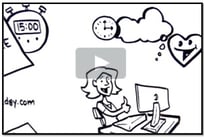 Something unique happens when we dive into and fully commit our energy to one task while letting everything else fade in the background. This forces us to go deeper and prompt us into moving the issues forward, into finding solutions, or even making breakthroughs. This is likely to unleash new levels of creativity, resourcefulness, and capabilities we may not even know we have.
Something unique happens when we dive into and fully commit our energy to one task while letting everything else fade in the background. This forces us to go deeper and prompt us into moving the issues forward, into finding solutions, or even making breakthroughs. This is likely to unleash new levels of creativity, resourcefulness, and capabilities we may not even know we have.
"But why don't we do this more often (working on one thing at a time)?" one might ask. Maybe because, while committing to one task is liberating, it is also frightening at the same time. It is frightening because we would have to face the challenges and fears that come with this task--or project, or issue. This includes the fear of not knowing, the fear of failure, and the fear of success. This also means facing procrastination and acting against our strong tendency of taking the path of least resistance.
So what would happen if we commit to this "one thing at a time" and face the challenges and fear that come with it? This is what is likely to happen:
a) We learn more, develop more, and gain more experience. As a result, not only we feel accomplished--something we are largely deprived of in today's everything-overload era, but we are also likely to achieve greater results over time and reap the benefits.
b) We accelerate the progress and make things happen faster-probably much faster than what multi-tasking can ever buy us. We are likely to get to the core issues and get there much sooner. We are likely to prompt decisions and actions which we would otherwise avoid or delay. This means we shorten the time to market and capture the windows of opportunities. In other words, we gain time--the next best thing to discovering the "fountain of youth".
c) We set precedence. This task, project, or issues that we face will be now on the "I can do it" list. Our subconscious has witnessed it which is very disarming for any related doubts and negative self-talk. The world has witnessed it which means it is now on our track record. Next time, not only we are ready to do it again, but probably take it a step further. The process continues to feed on itself.
These are important ingredients for feeling good, feeling accomplished, and being happy. So happiness is "working at one thing at a time" and is a choice!
So how do you turn the above into action? Let me know by adding your comment below!







 You have this report to write, or presentation to prepare, or project plan to put into place. It is daunting. Too many parts to it. Too many issues to think about. You find yourself deferring it and feeling a little anxious when you think about it. It is just too big of an undertaking, and/or a sign of procrastination, and/or a sign of wanting it to be nothing less than perfect . You end up delaying it until there is no room for delaying any further. Then it becomes a high pressure situation. In addition, work quality suffers. If other urgent demands come up at the same time, and they will, then you've got one of these "situations" on hand.
You have this report to write, or presentation to prepare, or project plan to put into place. It is daunting. Too many parts to it. Too many issues to think about. You find yourself deferring it and feeling a little anxious when you think about it. It is just too big of an undertaking, and/or a sign of procrastination, and/or a sign of wanting it to be nothing less than perfect . You end up delaying it until there is no room for delaying any further. Then it becomes a high pressure situation. In addition, work quality suffers. If other urgent demands come up at the same time, and they will, then you've got one of these "situations" on hand. You have this long to-do list, and items keep getting added to it, and the list gets longer and longer. So what do you do? Here are three suggestions that can help.
You have this long to-do list, and items keep getting added to it, and the list gets longer and longer. So what do you do? Here are three suggestions that can help.
